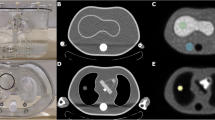Abstract
Purpose
The aim of this study was to investigate the effect of positron range on visualization and quantification in 18F, 68Ga and 124I positron emission tomography (PET)/CT of lung-like tissue.
Methods
Different sources were measured in air, in lung-equivalent foams and in water, using a clinical PET/CT and a microPET system. Intensity profiles and curves with the cumulative number of annihilations were derived and numerically characterized.
Results
68Ga and 124I gave similar results. Their intensity profiles in lung-like foam had a peak similar to that for 18F, and tails of very low intensity, but extending over distances of centimetres and containing a large fraction of all annihilations. For 90% recovery, volumes of interest with diameters up to 50 mm were required, and recovery within the 10% intensity isocontour was as low as 30%. In contrast, tailing was minor for 18F.
Conclusion
Lung lesions containing 18F, 68Ga or 124I will be visualized similarly, and at least as sharp as in soft tissue. Nevertheless, for quantification of 68Ga and 124I large volumes of interest are needed for complete activity recovery. For clinical studies containing noise and background, new quantification approaches may have to be developed.






Similar content being viewed by others
References
Champion C, Le Loirec C. Positron follow-up in liquid water: II. Spatial and energetic study for the most important radioisotopes used in PET. Phys Med Biol 2007;52:6605–25.
Sánchez-Crespo A, Andreo P, Larsson SA. Positron flight in human tissues and its influence on PET image spatial resolution. Eur J Nucl Med Mol Imaging 2004;31:44–51.
Blanco A. Positron range effects on the spatial resolution of RPC-PET. IEEE Nucl Sci Symp Conf Rec 2006;4:2570–3.
Jentzen W, Weise R, Kupferschläger J, Freudenberg L, Brandau W, Bares R, et al. A. Iodine-124 PET dosimetry in differentiated thyroid cancer: recovery coefficient in 2D and 3D modes for PET(/CT) systems. Eur J Nucl Med Mol Imaging 2008;35:611–23.
Vandenberghe S. Three-dimensional positron emission tomography imaging with 124I and 86Y. Nucl Med Commun 2006;27:237–45.
Robinson S, Julyan PJ, Hastings DL, Zweit J. Performance of a block detector PET scanner in imaging non-pure positron emitters—modelling and experimental validation with 124I. Phys Med Biol 2004;49:5505–28.
Herzog H, Tellman L, Qaim SM, Spellerberg S, Schmid A, Coenen HH. PET quantitation and imaging of the non-pure positron-emitting iodine isotope 124I. Appl Radiat Isot 2002;56:673–9.
Pentlow KS, Graham MC, Lambrecht RM, Daghighian F, Bacharach SL, Bendriem B, et al. Quantitative imaging of iodine-124 with PET. J Nucl Med 1996;37:1557–62.
Laforest R, Liu X. Image quality with non-standard nuclides in PET. Q J Nucl Med Mol Imaging 2008;52:151–8.
Alessio A, MacDonald L. Spatially variant positron range modeling derived from CT for PET image reconstruction. IEEE Nucl Sci Symp Conf Rec 2008;MO3-8:3637–40.
Palmer MR, Zhu X, Parker A. Modeling and simulation of positron range effects for high resolution PET imaging. IEEE Trans Nucl Sci 2005;52:1391–5.
Bahri MA, Plenevaux A, Warnock G, Luxen A, Seret A. NEMA NU4-2008 image quality performance report for the microPET Focus 120 and for various transmission and reconstruction methods. J Nucl Med 2009;50:1730–8.
Kalender WA, Fichte H, Bautz W, Zwick A, Rienmüller R, Behr J, et al. Reference values for lung density and structure measured by quantitative CT. In: Pokieser G, Lechner G, editors. Advances in CT III. Berlin: Springer; 1994. p. 290–8.
Kemerink GJ, Kruize HH, Lamers RJS, van Engelshoven JMA. Density resolution in quantitative computed tomography of foam and lung. Med Phys 1996;23:1697–708.
Evaluated nuclear structure data file (ENSDF), National Nuclear Data Center (NNDC). Brookhaven, USA. http://www.nndc.bn.gov/useroutput/AR_192531_2.html.
Nehmeh SA, Erdi YE. Respiratory motion in positron emission tomography/computed tomography: a review. Semin Nucl Med 2008;38:167–76.
Acknowledgment
The authors thank Prof. Dr. Guido Heidendal for reviewing the manuscript.
Conflicts of interest
None.
Author information
Authors and Affiliations
Corresponding author
Rights and permissions
About this article
Cite this article
Kemerink, G.J., Visser, M.G.W., Franssen, R. et al. Effect of the positron range of 18F, 68Ga and 124I on PET/CT in lung-equivalent materials. Eur J Nucl Med Mol Imaging 38, 940–948 (2011). https://doi.org/10.1007/s00259-011-1732-1
Received:
Accepted:
Published:
Issue Date:
DOI: https://doi.org/10.1007/s00259-011-1732-1




